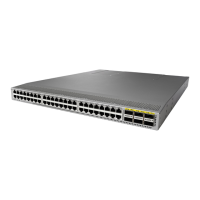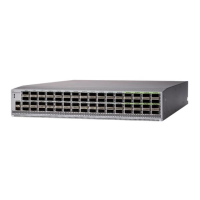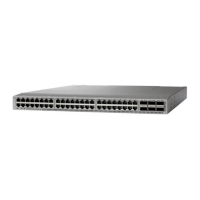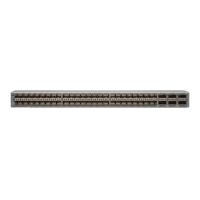• Use a breakout cable with a QSFP28 transceiver on one end and four SFP25 transceivers on the
other ends. To configure one or more ports to use this cable, use the interface breakout module
module_number port low_port_number[-high_port_number] map 25g-4x command. For the Cisco
Nexus 9236C switch, use 1 for the module_number. If you are configuring only one port, use the
port number in place of low_port_number. If you are configuring a range of ports, specify the port
numbers from low to high, such as port 2-15.
You can use a breakout cable that is up to 9.8 feet (3 meters) in length.
Note
• Use a CVR-2QSFP28-8SFP adapter for each 100-Gigabit port to operate at 25-Gigabits and configure
the port or range of ports to operate at 25-Gigabits by using the interface breakout module
module_number port low_port_number[-high_port_number] map 25g command. For the Cisco
Nexus 9236C switch, use 1 for the module_number. If you are configuring only one port, use the
port number in place of low_port_number. If you are configuring a range of ports, specify the port
numbers from low to high, such as port 2-15.
• For 10-Gigabit connectivity, you can do one of the following:
• Use a QSFP-to-SFP adapter, such as the CVR-QSFP-SFP10G adapter, so that you can connect
SFP+ or SFP transceivers to the QSFP28/QSFP+ ports. The 10-Gigabit speed is automatically set
up through the adapter connection.
• Use a breakout cable with a QSFP+ transceiver on the switch end and four SFP+ transceivers on
the other cable ends. To configure one or more ports to use this cable, use the interface breakout
module module_number port low_port_number[-high_port_number] map 10g-4x command. For
the Cisco Nexus 9236C switch, use 1 for the module_number. If you are configuring only one port,
use the port number in place of low_port_number. If you are configuring a range of ports, specify
the port numbers from low to high, such as port 2-15.
To determine which transceivers and cables are supported by this switch, see
http://www.cisco.com/c/en/us/support/interfaces-modules/transceiver-modules/products-device-support-tables-list.html.
To see the transceiver specifications and installation information, see
http://www.cisco.com/c/en/us/support/interfaces-modules/transceiver-modules/products-installation-guides-list.html.
Guidelines for Connecting Ports
You can use 100-Gigabit Quad Small Form Factor Pluggable 28 (QSFP28) or 40-Gigabit QSFP+ transceivers
for connections to other network devices using speeds of 100, 40, 25, or 10 Gigabits per second (you can use
breakout cables for 25- and 10-Gigabit connections).
For information about the transceivers currently being used with the switch, use the show inventory all
command.
Prevent damage to the fiber-optic cables that can separate from their cables. Keep the transceivers disconnected
from their fiber-optic cables when installing the transceiver in the line card. Before removing such a transceiver
from the switch, remove the cable from the transceiver.
To maximize the effectiveness and life of your transceivers and optical cables, do the following:
Cisco Nexus 9236C NX-OS Mode Switch Hardware Installation Guide
30
Connecting the Switch to the Network
Guidelines for Connecting Ports

